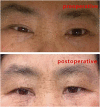Brown-Sequard syndrome associated with Horner syndrome following cervical disc herniation
- PMID: 28053775
- PMCID: PMC5156674
- DOI: 10.1038/scsandc.2016.37
Brown-Sequard syndrome associated with Horner syndrome following cervical disc herniation
Abstract
Introduction: Brown-Sequard syndrome (BSS) has been reported in patients with various spinal pathologies, including spinal traumatic injuries, spinal cord neoplasms, epidural hematomas and spinal cord ischemia. Pure BSS caused by cervical disc herniation is very rare.
Case presentation: We report a rare case of cervical disc herniation presenting as BSS associated with Horner syndrome (HS), which has not been reported up to now. A prompt diagnosis by magnetic resonance imaging (MRI), followed by spinal cord decompression was performed. A postoperative rapid improvement of the neurological deficits was observed.
Discussion: We review the literature and discuss the functional anatomy of spinal cord of BSS combined with HS. And it is important that clinicians be aware that a MRI of spinal cord is needed for those patients with a thoracic sensory level, and that a thoracic sensory level might not only depend on the level of spinal cord injury but also on the stage of evolution of the lesion.
Keywords: Development of the nervous system; Neurodegenerative diseases.
Figures


Similar articles
-
Spontaneous cervical intradural disc herniation presenting with Brown-Séquard and Horner's syndrome: lesson learned from a very unique case.Eur Spine J. 2017 May;26(Suppl 1):218-221. doi: 10.1007/s00586-017-5044-4. Epub 2017 Mar 25. Eur Spine J. 2017. PMID: 28343313 Review.
-
Progressive Brown-Séquard syndrome: A rare manifestation of cervical disc herniation.J Clin Neurosci. 2016 Jul;29:196-8. doi: 10.1016/j.jocn.2015.12.021. Epub 2016 Feb 23. J Clin Neurosci. 2016. PMID: 26921137
-
Brown-Sequard syndrome produced by cervical disc herniation with complete neurologic recovery: report of three cases and review of the literature.Spinal Cord. 2007 Nov;45(11):744-8. doi: 10.1038/sj.sc.3102025. Epub 2007 Feb 6. Spinal Cord. 2007. PMID: 17279099
-
A rare case of Brown-Sequard syndrome caused by traumatic cervical epidural hematoma.Surg Neurol Int. 2018 Oct 23;9:213. doi: 10.4103/sni.sni_142_18. eCollection 2018. Surg Neurol Int. 2018. PMID: 30488011 Free PMC article.
-
Brown-Sèquard syndrome produced by C3-C4 cervical disc herniation: a case report and review of the literature.Spine (Phila Pa 1976). 2008 Apr 20;33(9):E279-82. doi: 10.1097/BRS.0b013e31816c835d. Spine (Phila Pa 1976). 2008. PMID: 18427307 Review.
Cited by
-
Brown-Séquard Syndrome Caused by Acute Traumatic Cervical Disc Herniation.Korean J Neurotrauma. 2019 Sep 2;15(2):204-208. doi: 10.13004/kjnt.2019.15.e21. eCollection 2019 Oct. Korean J Neurotrauma. 2019. PMID: 31720278 Free PMC article.
-
An unusual case of Brown-Sequard syndrome associated with Horner's syndrome after a penetrating injury with a khuru (Bhutanese dart) to the neck: A case report.SAGE Open Med Case Rep. 2022 Aug 17;10:2050313X221116945. doi: 10.1177/2050313X221116945. eCollection 2022. SAGE Open Med Case Rep. 2022. PMID: 36003889 Free PMC article.
-
Cervical disc herniation causing Brown-Sequard syndrome: Case report and review of literature (CARE-compliant).Medicine (Baltimore). 2018 Sep;97(37):e12377. doi: 10.1097/MD.0000000000012377. Medicine (Baltimore). 2018. PMID: 30213001 Free PMC article. Review.
References
-
- Pouw MH, van de Meent H, van Middendorp JJ, Hirschfeld S, Thietje R, van Kampen A et al. Relevance of the diagnosis traumatic cervical Brown-Séquard-plus syndrome: an analysis based on the neurological and functional recovery in a prospective cohort of 148 patients. Spinal Cord 2010; 48: 614–618. - PubMed
-
- Abouhashem S, Ammar M, Barakat M, Abdelhameed E. Management of Brown-Sequard syndrome in cervical disc diseases. Turk Neurosurg 2013; 23: 470–475. - PubMed
-
- Porto GB, Tan LA, Kasliwal MK, Traynelis VC. Progressive Brown-Séquard syndrome: a rare manifestation of cervical disc herniation. J Clin Neurosci 2016; 29: 196–198. - PubMed
-
- Stookey B. Compression of the spinal cord due to ventral extradural cervical chondromas: diagnosis and surgical treatment. Arch Neurol Psychiatry 1928; 20: 275–291.
LinkOut - more resources
Full Text Sources
Other Literature Sources

